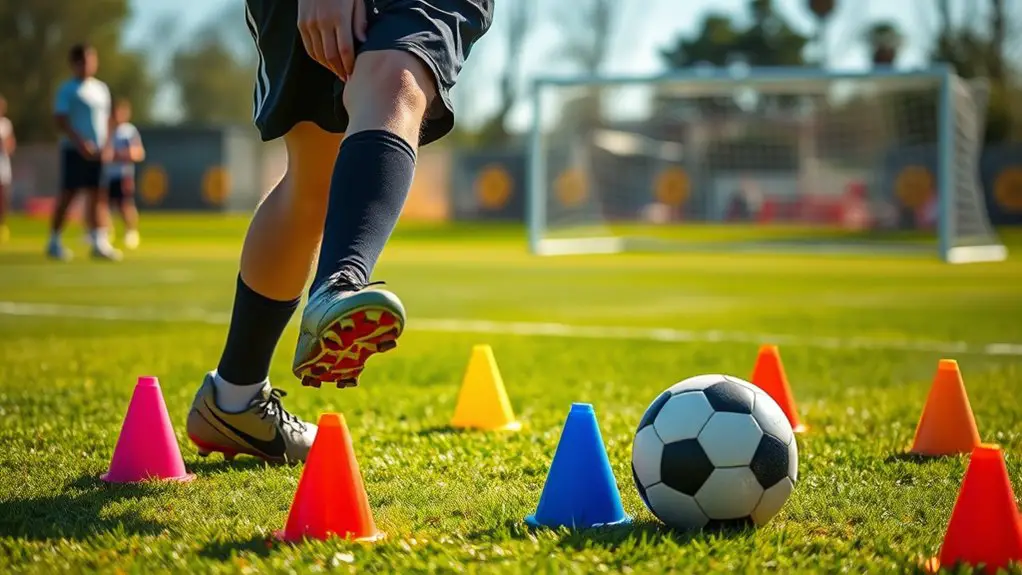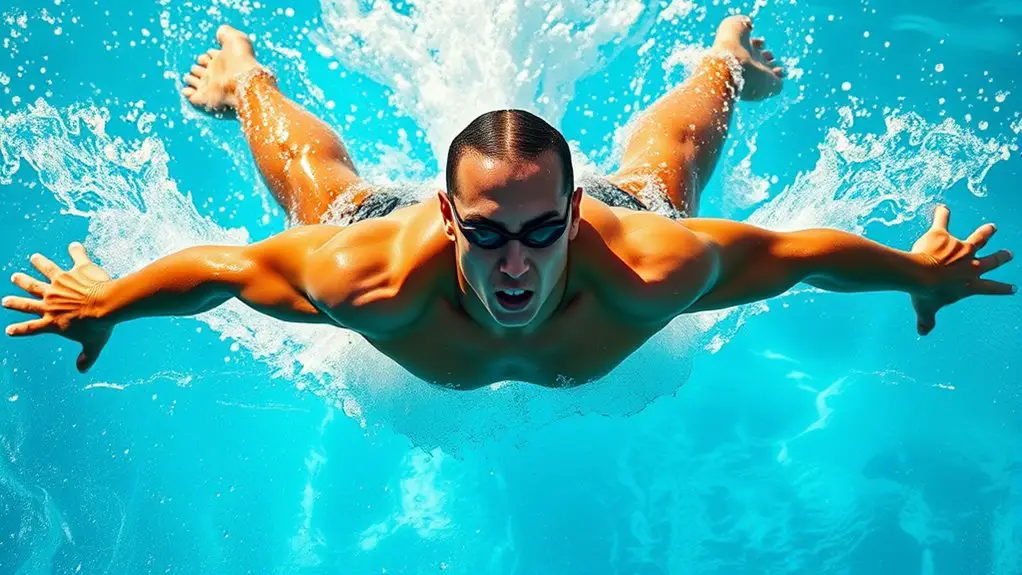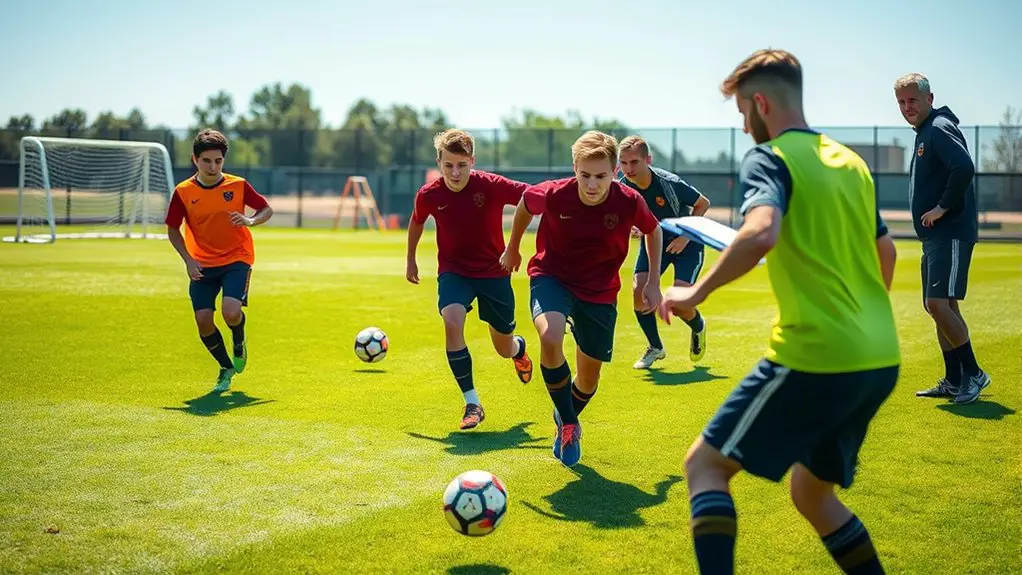To train upper body endurance for rowing, focus on strength exercises that target key muscle groups like the lats, traps, and core. Incorporate dumbbell rows, push-ups, and bodyweight exercises like pull-ups into your routine. Aim for two to three strength sessions weekly, along with endurance workouts on an ergometer. Remember to prioritize nutrition and hydration to support recovery. Discovering how to balance your training and nutrition can greatly boost your performance on the water.
Understanding Upper Body Endurance in Rowing
Upper body endurance is essential for rowers, as it directly impacts performance and efficiency on the water. When you're out there, each stroke relies heavily on your upper body strength and stamina. If your muscles tire too quickly, your form suffers, and every pull becomes a struggle. This isn't just about power; it's about maintaining that power throughout your outing, allowing you to glide through the water effortlessly.
Building upper body endurance means training your muscles to work longer without fatigue, giving you the freedom to push harder and enjoy your time on the water. You'll find that with improved endurance, you can maintain a steady rhythm, enhancing your overall experience. Incorporating exercises like the bench press can significantly boost your upper body power and endurance, allowing you to perform better on the water. So, focus on exercises that promote stamina, and you'll feel the difference not just in your performance, but in the joy of rowing itself. Embrace the journey, and let your upper body endurance set you free on the water.
Key Muscles Involved in Rowing
When you think about rowing, it's easy to focus on the legs, but your upper body plays an essential role too. The key muscles involved include your back, shoulders, and arms. Your latissimus dorsi, located on your back, helps you pull the oar effectively, providing power and stability. The trapezius and rhomboids work in harmony to support shoulder movement and posture, ensuring you maintain a strong, fluid stroke.
Don't overlook your biceps and triceps, as they're vital for the pulling motion and controlling the oar's release. Your chest muscles, particularly the pectorals, contribute to the overall strength and endurance needed for sustained rowing. Additionally, developing core strength is crucial as it enhances stability and power generation during each stroke.
Importance of Upper Body Strength for Rowers
While many may underestimate the role of upper body strength in rowing, it's essential for achieving peak performance. Your arms, shoulders, and back aren't just there for show; they're the powerhouse behind every stroke you take. When you've got strong upper body muscles, you can generate more power and maintain better control over your boat. This strength translates to improved endurance, allowing you to row longer without fatigue.
Moreover, a strong upper body helps with injury prevention. Rowing can be tough on your joints, but when your muscles are well-conditioned, they support and stabilize your movements, minimizing the risk of strain. Plus, let's not forget the mental edge that comes with strength training—knowing you're capable and strong can boost your confidence on the water. Embracing upper body strength isn't just about physical prowess; it's about releasing your true potential as a rower and enjoying the freedom of movement. Additionally, developing grip strength improves overall health and enhances your performance on the water.
Effective Exercises for Building Upper Body Endurance
When it comes to building upper body endurance, incorporating both resistance training techniques and bodyweight exercises can make a big difference. You'll want to focus on routines that challenge your muscles while mimicking the rowing motion. This combination will help you develop the strength and stamina needed for those long sessions on the water. Additionally, understanding upper-body muscles and their functions can enhance your training effectiveness and overall performance.
Resistance Training Techniques
To boost your upper body endurance as a rower, incorporating effective resistance training techniques is essential. These exercises help build the strength and stamina you need to power through long sessions on the water. Here are some techniques to evaluate:
- Dumbbell Rows: Mimic the rowing motion and target your back, arms, and shoulders effectively.
- Push-Ups: Build endurance in your chest, triceps, and shoulders while enhancing core stability.
- Resistance Bands: Use them for a variety of exercises like shoulder presses and lateral raises to improve muscle endurance without heavy weights.
Bodyweight Exercise Routines
Bodyweight exercises are an excellent way to build upper body endurance for rowers, as they utilize your own weight for resistance and can be done anywhere. Push-ups, pull-ups, and dips are fantastic choices that engage multiple muscle groups. You can modify these exercises to fit your level—try incline push-ups if you're just starting or explosive push-ups for a challenge. Incorporate planks to strengthen your core, which supports your upper body during rowing. Aim for higher repetitions to enhance endurance; consider doing circuits to keep things interesting and dynamic. Remember, consistency is key. So, embrace the freedom of bodyweight training, and enjoy the journey to improved endurance and performance on the water!
Incorporating Resistance Training Into Your Routine
While endurance is essential for rowers, incorporating resistance training into your routine can greatly enhance your overall performance. It's not just about building muscle; it's about improving your power and efficiency on the water. By integrating resistance training, you'll develop the strength needed to maintain your endurance during long rows.
Consider these key aspects when adding resistance training:
- Focus on compound movements: Exercises like bench presses and bent-over rows engage multiple muscle groups, maximizing your workouts.
- Vary your training: Use free weights, resistance bands, and machines to keep your workouts fresh and your body challenged.
- Prioritize recovery: Allow your muscles to recover between sessions to prevent overtraining and fatigue.
Incorporating functional strength training into your routine can also enhance your performance on the water.
With the right resistance training, you're not just rowing; you're empowering your body to perform at its peak, giving you the freedom to push your limits and enjoy every stroke on the water.
The Role of Core Strength in Upper Body Endurance
Your core strength plays an essential role in enhancing upper body endurance while rowing. A stable core not only supports your movements but also helps transfer power effectively from your lower body to your upper body. By incorporating specific core exercises into your training, you can greatly improve your overall performance on the water. Additionally, prioritizing mobility training can further enhance your upper body endurance by allowing for smoother and more efficient movements during rowing.
Importance of Core Stability
Core stability is essential for rowers, as it serves as the foundation for upper body endurance. A strong core allows you to transfer power effectively from your lower body through to your arms, making each stroke more efficient. When your core is stable, you can maintain proper posture and balance, reducing the risk of injury and enhancing performance. Here's why core stability matters:
- Improved power transfer: A strong core helps you harness energy from your legs and deliver it through your arms.
- Postural control: Stability keeps your body aligned, allowing for smoother and more controlled movements.
- Injury prevention: A stable core minimizes stress on your back and shoulders, protecting you from overuse injuries.
Investing in core stability will liberate your rowing experience!
Core Exercises for Rowers
Building on the importance of core stability, incorporating targeted core exercises can greatly enhance upper body endurance for rowers. A strong core supports your entire rowing motion, allowing you to transfer power effectively. Plank variations, Russian twists, and bicycle crunches are excellent choices to build that strength. These exercises not only stabilize your torso but also improve your control and balance in the boat. By focusing on your core, you'll notice increased efficiency in your strokes, helping you row longer without fatigue. Don't underestimate the role of a well-conditioned core; it's the foundation for your upper body endurance. Embrace these exercises, and you'll feel the difference as you glide effortlessly through the water, enjoying the freedom of each stroke.
Core and Upper Strength
While many may focus solely on upper body strength for rowing, it's vital to recognize how core strength plays an important role in enhancing upper body endurance. A strong core stabilizes your body, allowing your arms to perform efficiently without fatigue. This synergy not only boosts your performance but also minimizes injury risk.
Consider these core benefits:
- Improved Stability: A solid core helps maintain proper posture, fundamental for effective rowing.
- Enhanced Power Transfer: Your core acts as a bridge, transferring power from your legs to your upper body seamlessly.
- Increased Endurance: A robust core allows you to row longer without compromising form, keeping you free to push your limits.
Embrace core training, and you'll reveal your full potential on the water!
Designing a Balanced Training Program
To create an effective upper body endurance training program for rowers, it's essential to strike a balance between strength, endurance, and recovery. Start by incorporating strength training exercises that target the major muscle groups involved in rowing, like your back, shoulders, and arms. Aim for two to three sessions a week, focusing on compound movements like pull-ups and rows.
Incorporating upper body workouts that enhance shoulder and arm strength can further improve your rowing performance. Next, integrate endurance workouts that elevate your heart rate while engaging your upper body. Consider activities like rowing on an ergometer for longer durations or incorporating circuit training.
Don't forget about recovery—it's just as important. Schedule rest days and include flexibility work like stretching or yoga to enhance mobility.
Nutrition Tips for Enhanced Performance
After establishing a solid upper body endurance training program, focusing on nutrition can greatly boost your performance on the water. The right fuel can enhance your energy levels, recovery, and overall strength. Here are some tips to reflect upon:
Focusing on nutrition post-training can significantly elevate your performance and recovery on the water.
- Hydrate Wisely: Water is essential, but electrolytes can help replenish what you lose during intense sessions. Staying hydrated supports optimal performance; dehydration can impair energy and focus.
- Prioritize Protein: Incorporate lean proteins into your meals to support muscle repair and growth. Think chicken, fish, or plant-based options.
- Carb Up: Don't shy away from complex carbohydrates. They'll provide sustained energy for those long rowing sessions.
Monitoring Progress and Adjusting Your Training Plan
As you progress in your upper body endurance training, it is crucial to regularly monitor your performance and adjust your training plan accordingly. Use a simple log or app to track your workouts, noting weights, repetitions, and how you feel post-session. This data helps you identify trends in your strength and endurance levels.
If you notice stagnation or fatigue, don't hesitate to tweak your routine. Increase weights, vary your exercises, or adjust your rest periods to keep your body challenged. Listening to your body is key—if something feels off, take a step back and reassess. Signs of inadequate recovery can indicate that you need to modify your training plan.
Set specific, achievable goals to maintain motivation and freedom in your training. Celebrate small victories to keep your spirits high. Remember, endurance isn't just about pushing hard; it's about smart, adaptable training that suits your unique journey. Keep evolving, and you'll find the rhythm that works best for you.
Frequently Asked Questions
How Long Should I Train for Upper Body Endurance Each Week?
You've got the freedom to choose your training duration! Aim for three to four sessions weekly, each lasting 30 to 60 minutes. Consistency's key, so listen to your body and adjust as needed.
Can I Improve Endurance Without Access to a Gym?
You can improve endurance without a gym by using bodyweight exercises, resistance bands, or outdoor activities. Consistency's key, so create a routine that fits your lifestyle and enjoy the freedom to train anywhere!
What Are Common Mistakes in Upper Body Endurance Training?
You might think you're pushing your limits, but neglecting proper form, overtraining, or skipping warm-ups can actually hinder your progress. Embrace balance and listen to your body for true freedom in your upper body endurance journey.
How Does Hydration Affect Upper Body Endurance Performance?
Hydration's essential for upper body endurance. When you're properly hydrated, your muscles function better, reducing fatigue and improving performance. Skipping water can lead to decreased strength and stamina, so keep sipping throughout your training sessions!
Should I Focus on Endurance or Strength Training First?
Like a sculptor chiseling away at marble, you should first focus on endurance. Building a strong foundation enhances your overall performance, allowing strength training to be more effective later. Embrace the journey; it's liberating!



